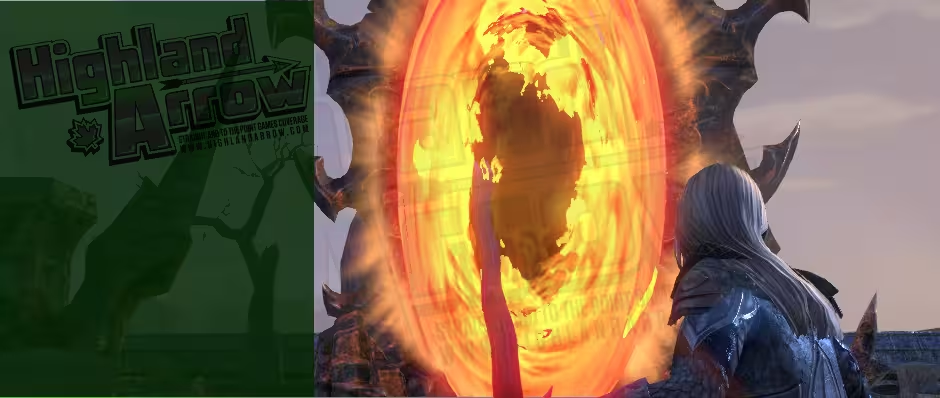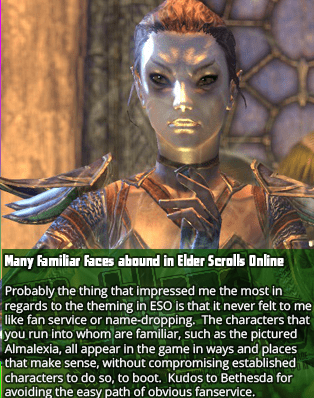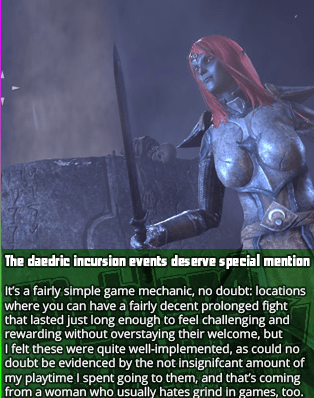

The Elder Scrolls Online
Platforms: PC
Reviewed on: PC
Reviewer: Maiyannah Bishop
Review Play-Time: 104h
Developer: Zenimax Online Studios
Publisher: Bethesda Softworks
Released: 2022-06-14
Review Published: 2015-03-31
+ Nails the Elder Scrolls look & feel
+ Very strong art direction and decent fidelity
+ Tactical combat is tight mechanically
+ Impressive uses of instancing and scaling
+ Entirely playable both in groups and solo
- Many puzzles in quests are busy-work
- Lack of a strong over-arching narrative hurts the
experience
- Spell-casting and enchanting are very neutered
-Some instances of rather unfair difficulty
- Issues with pay store

Editor's Note: Maiyannah's copy of Elder Scrolls Online was provided free of charge by a reader. The original version of this review included a comment about FOV not being a setting which is no longer true and has thus been amended. As well, an additional paragraph with some minor, niche comments was added.
The Elder Scrolls Online is the fifth installment in the venerable Elder Scrolls series developed by Zenimax Online Studios and published by Bethesda Softworks. I found myself with mixed feelings when a reader got me a gift copy of ESO to look at. It's no small secret to those that know of me that I'm something of an Elder Scrolls fan at the very least, but I have always been lukewarm at best with most MMOs, and most of what I'd heard about ESO had given me much reason to pause for consideration, and indeed the strength of some of those comments are a lot of the reason I hadn't looked at it until now.
I'm somewhat happy to report that while it certainly has some problems, ESO functions pretty well, both as a MMO, and as an Elder Scrolls game. Almost relieved, really, because I wasn't looking forward to being a dissenting opinion on this one if I didn't like it, because there would always be the question in my mind if I didn't like it simply because it was different. And it is different, but also very familiar.
Elder Scrolls Online really nails the look and feel of Tamriel

That really is one of the main reservations I had, especially given that a lot of people had claimed that it wasn't a "true Elder Scrolls game" - whatever that would mean, since that seems a fairly subjective claim. It feels very much like an Elder Scrolls game, however, with an obvious attention given to looking similar to the previous installments when you're in their respective areas - the Rift and Eastmarch resemble as they were in Skyrim, Deshaan and Stonefalls evoking the imagery of Morrowind, and likewise. One of the biggest complaints about ESO when it was in beta was that it didn't really feel like it hit the mark when it came to theme, and I can't speak to the beta, but the game as it is now certainly feels like it.
While I was playing Elder Scrolls Online for review I made a quip on twitter to the effect that if you're playing a dunmer (dark elf) and not doing it to the Nerevar Rising theme that was Morrowind's main titles you're doing it wrong, and while that remark was rather off the cuff or tongue-in-cheek as it were, it's also indicative of how at-home ESO seems in the well-worn boots of it's predecessors. It's hard not to get drawn into the world of Tamriel as painted in ESO, and it is equally difficult not for the game's sights in Cyrodiil played over the main theme of Oblivion not to bring to mind the authoritative tones of Sir Patrick Stewart in his role as the Emperor in that previous entry in the series.
Indeed, much of the appeal of Elder Scrolls Online is in that banking on nostalgia, and there is a fine line for a developer to walk between pandering to its audience with the likes of fan-service, but Elder Scrolls Online, to my mind, does a good job of avoiding that particular pitfall. Areas are included more for accuracy's sake than authenticity seemed the vibe I got, and indeed, many places were changed, some for the better and others for the worse, to reflect the fact that Elder Scrolls Online takes place in what would be the past to the likes of Oblivion or Skyrim. I was impressed with how the lore of the locations was respected, but not expounded upon, a subtlety that is often lost on the AAA games industry these days. Much is left for the player to seek out and discover if they so please, and you can play through the entire "story arc" of the game without ever even finding about a good solid quarter of what the game has to offer. It does a good job likewise of having the lore and the important characters whom appear in the quests go hand-in-hand - one is never in the service to the other, both the new lore of ESO and the existing lore are carefully considered, and unlike World of Warcraft, this hasn't resulted in a series of questionable retcons to the existing canon so that new stories could be made. It shows a considerable amount of careful thought on the part of the developers, and that's certainly something I appreciated in the game.
The art design in Elder Scrolls Online is quite remarkable
Some would say that I somewhat state the obvious in saying it, as the creative thought and design put into the lore and art design of Tamriel has always been the strong point of Bethesda Softworks, and something that marries well with the exploration-based sandbox play that so oft becomes the focus of Elder Scrolls games, but they have certainly delivered again with Elder Scrolls Online. The game looks quite good, both in terms of design and fidelity, with original details given to old motifs in the series' designs as well as some new flourishes unique to Elder Scrolls Online. The variety of game options allow you to disable or enable visual effects at will, include several resolution options, many of which are non-standard, which is great, and TotalBiscuit would probably be quite pleased to note the game has his field of view slider. Notably the blur and bloom effects can be disabled, which is kind of a personal bugbear of mine because those more than field of view contribute to my own problems playing games, and not all games allow you to adjust such.
One thing that stood out to me in particular was that the game in general (though there's a few exceptions) does a good job of having armour and weapons that actually seem believable, rather than the standard fantasy fare of oversized pauldrons and utterly impractical blades. It's an especial attention to detail I always liked in the Elder Scrolls series and ESO certainly does a good job of drawing on traditional blade designs and then making them appear fantasy-ish rather than coming up with the utterly-impractical hogwash that many games often do.
Mechanically, Elder Scrolls Online isn't anything too new,
but it's a quite tight refinement on the series' core mechanics
The game is built around the same core formula the series has enjoyed since Daggerfall, and like the installments since the series' venerable first modern ancestor, the main difference comes in the consolidation and reshuffling of the skills available more than anything - the core mechanic of the skills gaining rank over use, and a certain amount of skill use resulting in a level up remains present in Elder Scrolls Online. it's one that's always seemed to the series' benefit, creating a feeling of natural progression with a skill as the player themselves uses it and becomes more comfortable with it, which makes the experience seem much less artificial than the more by-the-numbers kind of system that has always been something like Dungeons & Dragons, or to a much lesser degree, Runequest.
The main variations introduced in Elder Scrolls Online are two: firstly, the classes are much more rigidly-defined, and the available skills are therefore somewhat restricted by class, and secondly, the skills are divided into concrete active or passive abilities they grant the player. I find both of these main changes to on the whole be beneficial to the game, though the former comes with some not insignificant caveats. Since spell-casting is reserved to a couple of classes in the game and each class only gets three skillsets with a handful of abilities each, the great wealth of different spells and spell effects, both in enchanting crafting but more importantly in combat, are greatly diminished. Most of the magical abilities in the game do fulfill series staples of abilities, to be fair, but when it comes to a pure mage, you number of available abilities is pretty threadbare. Likewise, since you can only slot five given active abilities and one "ultimate" ability at any given time, your selection only seems all the more bare. The size of that selection wasn't a huge problem to me personally, since I usually tend to focus on a good one-two punch in MMOs in terms of attacks and then leave the other abilities for support or healing abilities, but I can definitely see someone used to WoW's piano-keyboards sized selection of quick abilities being rather disappointed in it. Nonetheless, breaking the skills down into what tangible benefits they give the player takes a lot of the guesswork out of the Elder Scroll's previous formula, and makes it much more clear what skills do what.
Some of my personal bugbears with MMO game design appear, the one I feel being noteworthy being the fact that commuting just about anywhere can be a chore. Since the game doesn't want players to run out of enemies to fight to grind experience, especially in a player-rich community, the landscape is absolutely crawling with enemies in most places. This is Elder Scrolls Online's particular brush with a lack of subtlety I suppose; I could find no real clear and empty retreats short of areas that are pretty much made for that purpose. To Bethesda's credit, they've done a good job of at least making this seem for various reasons in the game world, and it doesn't seem as forced as it very easily could, but it's still a pain, especially when you're trying to get to a location for a timed event.
As to those locations, there's a fair variety of places to go, and they each have their little stories, but more importantly, a purpose. From simple dungeon crawls that offer experience to crafting workshops that offer a place to go for players unable to enter cities to craft, there's a wealth of different locations in the game, and the hotspot Daedric incursions from Molag Bal serve as continual hotspots for cooperative player action, activated on the cue of a player coming across them when they haven't been activated in a certain amount of time, and then giving the player and others in the immediate vicinity a light puzzle but more importantly a continual source of conflict and something to do in a given area when all of the dungeon delves are cleared. Although the dungeons themselves respawn and are infinitely replayable, they are static in design, save that the main ones scale to party leader level, and the incursion hot-spots while less complex in mechanics tend to always offer at least something different in terms of enemies since they appear to be pulled from leveled lists of a variety of them, and also the occasional named special enemy will appear as well, something to no doubt tease the OCD of achievement hunters since they have attached achievements.
Elder Scroll Online's instancing and
scaling are one of the best I've seen
I was impressed enough with how Elder Scrolls Online deftly handles instancing and phased gameplay that I felt it warranted its own special mention, and thus, here we are. The game does an absolutely brilliant job of keeping all the players together in an area, but also having phased instances as the town or area goes through its particular story progression. It's difficult to explain without getting into spoiler territory, and I was surprised to learn that most of the examples I could think of aren't detailed at any length in the wikis, so I think I'll avoid a specific example, however, ESO does a masterful job of designing the story encounters in a way that feels natural, and uses phasing in subtler ways to reflect changes, while at the same time avoiding the appearance that the other players who are in that area with you are acting strangely or erratically.
It's hard to understate the importance of the fact that ESO keeps all of the players together for the most part, as one of my biggest bugbears in WoW was randomly losing party members because they weren't at the same phase of an area you were when you went through it - I lost many a companion off a flying shared steed that way, as have my friends often lost me that way, in WoW - and the aggressive instances with a limit of 100 players in Champions Online were a constant source of trouble when trying to play in groups or arrange a large group roleplay session. Elder Scrolls online eschews with that entirely, with players always visible and available to each other in the overworld, so forming groups to go journey forth to whatever quest or task takes your fancy is never a bother, and it makes interaction in the world easy and without fuss.
That the game can be played through solo or
in group works in its favour
Let's face it: there are many introverts like myself who probably didn't want the next Elder Scrolls installment to be online because we didn't want to deal with having to group with a bunch of ponces to get places in the game. Or, perhaps like Yahtzee, you want to play a game by yourself, where everyone can see you. Irrespective of which of those or neither you fall under, the game is quite playable either solo or in groups, with even the instanced group dungeons solo-able if you specifically tailor the abilities and gear you bring into the instance for that dungeon and you have a penchant for getting smacked around a lot (Souls fan, perhaps?), and the scaling of the game again shines with presenting you challenges that never feel terribly underwhelming even if you have a large group.
This attention to the scaling and balance does a good job of catering to both audiences, I feel: those whom simply wanted more Elder Scrolls can happily ignore all the other players and simply proceed on their own, and just acknowledge the game will be a bit more difficult for the decision, and those looking for the more traditional MMO experience can group up with friends to do whatever they please, with the game quite excellently making sure that they have an appropriate challenge.
Encounter design is probably the one big sore spot
as yet unmentioned

The sore spots in the challenge of Elder Scrolls Online come regardless of your decision to play solo or in a group, and they come down to three chief complaints: puzzles that one can only call thus loosely for they are mostly routines of rote instruction-following, busy-work fetch quests, and bosses that don't play by the rules. I think the first two are mostly self-evident in what I mean by them, but the third is a particular thorn in the game design's otherwise well-wrought side, as the "boss" characters don't play by the same rules as everyone else, and thusly, are artificially difficult.
Champions Online did the same thing in this regard, and I was equally as frustrated when they did it: half your abilities' affects simply don't work on bosses. You have such a minimal chance to interrupt their "fuck you" attacks that you may as well not even try, and stuns, roots, and other crowd control abilities simply don't work on them. This can render entire builds unable to deal with certain bosses, and there was one that so frustrated me and wasted so much of my time with it's utter nonsense that I'll be damned if I don't waste your time with it too, dear reader. In one of the dungeons I played, with a group no less, there was one encounter with three healers and some underlings to run interference. In design it was simple to grasp what to do here: you have to rush down one of the healers, and have the other party members interrupt the other two to prevent them from healing their comrade before you can kill them. However, the fact that one of the enemies is one of these more powerful "boss" characters has an effect on that otherwise simple design akin to throwing a military-grade explosive in the road to blow up a Smart car, and even with a large group it took some time to get through that encounter, to say nothing of the many, many deaths and minutes wasted with the friend I was trying to duo through the dungeon with prior to asking for help.
Remembering that encounter actually brings to mind another, albeit rather minor, complaint with the game design, and that's where while you can normally just resurrect at the nearest wayshrine when you die (and these are rather shrewdly placed just far enough apart that dying becomes a penalty without being unduly harsh) or at the spot if you have a filled soul gem to power the magic for it, if you are in a "boss fight" you cannot do this, the option is not presented. You have to wait for your companion to finish the fight, for good or for ill, or for someone else to resurrect you, which is unlikely to happen when a boss or their minions is disrupting the party. So if you die in a boss fight, you might as well alt-tab out of the game to have a quick jill off or watch a YouTube video or something, because your likely to be just sitting there for a bit otherwise.
The story presented in Elder Scrolls Online is well-written,
but it lacks the gravitas necessary to really give the game
narrative teeth
In grand Elder Scrolls tradition, the game starts the player in media res as a prisoner for largely-unspecified reasons, this time of the Daedric Lord Molag Bal in his realm of Coldharbour. Much like Oblivion, one of the finest parts of the game is the depiction of that strange daemonic world, and Coldharbour is no exception, but you're not given much time to admire it before Lyris Titanborn comes to free you from the clutches of this prison, catapaulting the player character into a main storyline focusing on the plot of Molag Bal to merge Coldharbor and Nirn into one and thereby achieve conquest of Tamriel. The voice acting in particular is quite brilliant, with Michael Gambon cast quite well as the enigmatic Moth Priest known only as "The Prophet" who serves as the players mentor of sorts, and an absolutely standout performance of Malcolm McDowell in his most menacing as the antagonist Molag Bal. The campaign is given at a good clip, every five levels basically, and is quite an interesting story itself.
However, the nature of that pacing, ultimately no doubt in service to that always looming cloud of "MMO", is one of the problems ESO has. To be fair, the series in general has it too, but it's especially compounded in ESO. And that issue is that it's easy to lose sight of that over-arching goal of saving the world when you're constantly pulled in fifty million different directions with all the different side-quests, collectibles, and other players demanding your attention. And that lack of a sense of urgency does take quite a bit of wind out of the sails of the otherwise rather well-written story quest arc. It's a shame, actually, in that light, given that otherwise the story is quite strong.
There's a few minor or niche concerns in ESO - though none of them are major complaints. The game does a great job of having a variety of roleplaying emote animations and other tools for roleplay in there, which are sparsely-documented at best, which was the one thing I noticed. Not difficult to look up on the wikis, but something that could have used some documentation. The character creation has all the usual sliders, but a couple of the races end up looking rather samey by design, Imperials and Bretons in particular, though thankfully they are differentiated by the armour. And the one effect you can't disable in the options - J J Abrams style lens flares on portals and the like - is probably the most annoying one present. Likewise, if you're one of the troglodytes who buys the game somewheres that isn't Steam, perhaps in a box, or just a third party, you'll have to just enjoy the game as is, because the microtransaction store just isn't going to work for you. None of them big complaints, but likely worth mentioning, and so, here we are.


